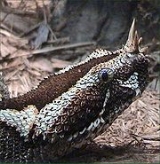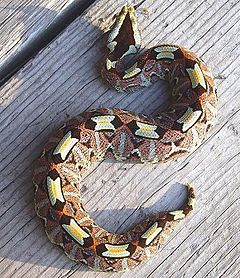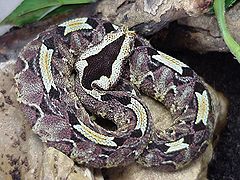
Bitis nasicornis
Encyclopedia
- Common names: rhinoceros viper, river jack, more.
Bitis nasicornis is a venomous
Venomous snake
"Poisonous snake" redirects here. For true poisonous snakes, see Rhabdophis.Venomous snakes are snakes which have venom glands and specialized teeth for the injection of venom...
viper
Viperinae
The Viperinae, or viperines, are a subfamily of venomous vipers found in Europe, Asia and Africa. They are distinguished by their lack of the heat-sensing pit organs that characterize their sister group, the Crotalinae. Currently, 12 genera and 66 species are recognized...
species
Species
In biology, a species is one of the basic units of biological classification and a taxonomic rank. A species is often defined as a group of organisms capable of interbreeding and producing fertile offspring. While in many cases this definition is adequate, more precise or differing measures are...
found in the forests of West
West Africa
West Africa or Western Africa is the westernmost region of the African continent. Geopolitically, the UN definition of Western Africa includes the following 16 countries and an area of approximately 5 million square km:-Flags of West Africa:...
and Central Africa
Central Africa
Central Africa is a core region of the African continent which includes Burundi, the Central African Republic, Chad, the Democratic Republic of the Congo, and Rwanda....
. A big viper known for its striking color pattern and prominent horns on its nose. No subspecies are recognized.
Description
Large and stout, ranging in length from 72 cm to 107 cm. Spawls et al. (2004) mention a maximum length of 120 cm, but admit that this is exceptional, quoting an average length of 60–90 cm. Females become larger than males.
Midbody there are 31-43 dorsal scale rows. These are so rough and heavily keeled
Keeled scales
Keeled scales refer to reptile scales that, rather than being smooth, have a ridge down the center that may or may not extend to the tip of the scale, making them rough to the touch...
that they sometimes inflict cuts on handlers when the snake struggles. There are 117-140 ventral scales
Ventral scales
In snakes, the ventral scales are the enlarged and transversely elongated scales that extend down the underside of the body from the neck to the anal scale. When counting them, the first is the anteriormost ventral scale that contacts the paraventral row of dorsal scales on either side...
and the anal scale
Anal scale
In snakes, the anal scale is the scale just in front of and covering the cloacal opening. This scale can be either single or paired . When paired, the division is oblique. It is preceded by the ventral scales and followed by the subcaudal scales....
is single. Mallow et al. (2003) say that the subcaudals number 16-32 with males having a higher count (25-30) than females (16-19). Spawls et al. (2004) state that there are 12-32 subcaudals, that they are paired, and that males having higher numbers of them.
The color pattern consists of a series of 15-18 blue or blue-green oblong markings, each with a lemon-yellow line down the center. These are enclosed within irregular black rhombic blotches. A series of dark crimson triangles run down the flanks, narrowly bordered with green or blue. Many of the lateral scales have white tips, giving the snake a velvety appearance. The top of the head is blue or green, overlaid with a distinct black arrow mark. The belly is dull green to dirty white, strongly marbled and blotched in black and gray. Western specimens are more blue, while those from the east are more green. After they shed their skin, the bright colors fade quickly as silt from their generally moist habitat accumulates on the rough scales.
Common names
Rhinoceros viper, river jack, rhinoceros horned viper, riverjack, horned puff adder.Geographic range
From GuineaGuinea
Guinea , officially the Republic of Guinea , is a country in West Africa. Formerly known as French Guinea , it is today sometimes called Guinea-Conakry to distinguish it from its neighbour Guinea-Bissau. Guinea is divided into eight administrative regions and subdivided into thirty-three prefectures...
to Ghana
Ghana
Ghana , officially the Republic of Ghana, is a country located in West Africa. It is bordered by Côte d'Ivoire to the west, Burkina Faso to the north, Togo to the east, and the Gulf of Guinea to the south...
in West Africa
West Africa
West Africa or Western Africa is the westernmost region of the African continent. Geopolitically, the UN definition of Western Africa includes the following 16 countries and an area of approximately 5 million square km:-Flags of West Africa:...
, and in Central Africa
Central Africa
Central Africa is a core region of the African continent which includes Burundi, the Central African Republic, Chad, the Democratic Republic of the Congo, and Rwanda....
in the Central African Republic
Central African Republic
The Central African Republic , is a landlocked country in Central Africa. It borders Chad in the north, Sudan in the north east, South Sudan in the east, the Democratic Republic of the Congo and the Republic of the Congo in the south, and Cameroon in the west. The CAR covers a land area of about ,...
, southern Sudan
Sudan
Sudan , officially the Republic of the Sudan , is a country in North Africa, sometimes considered part of the Middle East politically. It is bordered by Egypt to the north, the Red Sea to the northeast, Eritrea and Ethiopia to the east, South Sudan to the south, the Central African Republic to the...
, Cameroon
Cameroon
Cameroon, officially the Republic of Cameroon , is a country in west Central Africa. It is bordered by Nigeria to the west; Chad to the northeast; the Central African Republic to the east; and Equatorial Guinea, Gabon, and the Republic of the Congo to the south. Cameroon's coastline lies on the...
, Gabon
Gabon
Gabon , officially the Gabonese Republic is a state in west central Africa sharing borders with Equatorial Guinea to the northwest, Cameroon to the north, and with the Republic of the Congo curving around the east and south. The Gulf of Guinea, an arm of the Atlantic Ocean is to the west...
, Congo
Republic of the Congo
The Republic of the Congo , sometimes known locally as Congo-Brazzaville, is a state in Central Africa. It is bordered by Gabon, Cameroon, the Central African Republic, the Democratic Republic of the Congo , the Angolan exclave province of Cabinda, and the Gulf of Guinea.The region was dominated by...
, DR Congo
Democratic Republic of the Congo
The Democratic Republic of the Congo is a state located in Central Africa. It is the second largest country in Africa by area and the eleventh largest in the world...
, Angola
Angola
Angola, officially the Republic of Angola , is a country in south-central Africa bordered by Namibia on the south, the Democratic Republic of the Congo on the north, and Zambia on the east; its west coast is on the Atlantic Ocean with Luanda as its capital city...
, Rwanda
Rwanda
Rwanda or , officially the Republic of Rwanda , is a country in central and eastern Africa with a population of approximately 11.4 million . Rwanda is located a few degrees south of the Equator, and is bordered by Uganda, Tanzania, Burundi and the Democratic Republic of the Congo...
, Uganda
Uganda
Uganda , officially the Republic of Uganda, is a landlocked country in East Africa. Uganda is also known as the "Pearl of Africa". It is bordered on the east by Kenya, on the north by South Sudan, on the west by the Democratic Republic of the Congo, on the southwest by Rwanda, and on the south by...
and western Kenya
Kenya
Kenya , officially known as the Republic of Kenya, is a country in East Africa that lies on the equator, with the Indian Ocean to its south-east...
. The type locality is listed only as "interior parts of Africa."
Habitat
Occurs in forested areas, rarely venturing into woodlands. Its range is therefore more restricted than B. gabonicaBitis gabonica
Bitis gabonica is a venomous viper species found in the rainforests and savannas of Sub-Saharan Africa. This is not only the largest member of the genus Bitis, but also the world's heaviest viperid and it has the longest fangs ,and the highest venom yield of any venomous snake...
.
Behavior
Primarily nocturnal, they hide during the day in leaf litter, in holes, around fallen trees or tangled roots of forest trees. Their vivid coloration actually gives them excellent camouflage in the dappled light conditions of the forest floor, making them almost invisible. Although mainly terrestrial, they are also known to climb into trees and thickets where they have been found up to 3 m above the ground. This climbing behavior is aided by a tail that is prehensile to a certain extent. They are sometimes found in shallow pools and have been described as powerful swimmers.
They have been described as generally placid creatures; less so than B. gabonica
Bitis gabonica
Bitis gabonica is a venomous viper species found in the rainforests and savannas of Sub-Saharan Africa. This is not only the largest member of the genus Bitis, but also the world's heaviest viperid and it has the longest fangs ,and the highest venom yield of any venomous snake...
, but not as bad-tempered as B. arietans
Bitis arietans
Bitis arietans is a venomous viper species found in savannah and grasslands from Morocco and western Arabia throughout Africa except for the Sahara and rain forest regions. It is responsible for causing the most fatalities in Africa owing to various factors, such as its wide distribution and...
. When approached, they often reveal their presence by hissing. Said to produce the loudest hiss of any African snake—almost a shriek.
Feeding
Prefers to hunt by ambush, probably spending much of its life motionless, waiting for prey to wander by. Froesch (1967) described a captive specimen that would hardly ever leave its hide box, even when hungry, and once waited for three days for a live mouse to enter its hide box before striking. Feeds mainly on small mammals, but in wetland habitats it is also known to take toads, frogs and even fish. One long-term captive specimen, regularly fed pre-killed mice and frogs, always held on to its prey for several minutes after a strike before swallowing.Reproduction
In West AfricaWest Africa
West Africa or Western Africa is the westernmost region of the African continent. Geopolitically, the UN definition of Western Africa includes the following 16 countries and an area of approximately 5 million square km:-Flags of West Africa:...
, the species gives birth to between 6 and 38 young in March-April at the beginning of the rainy season. Neonates are 18–25 cm in length. In eastern Africa the breeding season is indefinite.
Venom
Because of its restricted range, few bites have been reported. No statistics are available.Relatively little is known about the toxicity and composition of the venom. In mice, the intravenous is 1.1 mg/kg. The venom is supposedly slightly less toxic than those of B. arietans
Bitis arietans
Bitis arietans is a venomous viper species found in savannah and grasslands from Morocco and western Arabia throughout Africa except for the Sahara and rain forest regions. It is responsible for causing the most fatalities in Africa owing to various factors, such as its wide distribution and...
and B. gabonica
Bitis gabonica
Bitis gabonica is a venomous viper species found in the rainforests and savannas of Sub-Saharan Africa. This is not only the largest member of the genus Bitis, but also the world's heaviest viperid and it has the longest fangs ,and the highest venom yield of any venomous snake...
. The maximum wet venom yield is 200 mg. One study reported that this venom has the highest i.m. LD50 value—8.6 mg/kg—of five different viperid venoms tested (B. arietans, B. gabonica, B. nasicornis, Daboia russelii and Vipera aspis
Vipera aspis
Vipera aspis is a venomous viper species found in southwestern Europe. Bites from this species can be more severe than from the European adder, V. berus; not only can they be very painful, but about 4% of all untreated bites are fatal...
). Another showed that there was little variation in the venom potency of these snakes, whether they were milked once every two days or once every three weeks. In rabbits, the venom is apparently slightly more toxic than that of B. gabonica
There are only a few detailed reports of human envenomation. Massive swelling, which may lead to necrosis, had been described. In 2003 a man in Dayton, Ohio
Dayton, Ohio
Dayton is the 6th largest city in the U.S. state of Ohio and the county seat of Montgomery County, the fifth most populous county in the state. The population was 141,527 at the 2010 census. The Dayton Metropolitan Statistical Area had a population of 841,502 in the 2010 census...
, who was keeping a specimen as a pet, was bitten and subsequently died. There is at least one antivenin that protects specifically against bites from this species: India Antiserum Africa Polyvalent.
External links
- Rhinoceros viper at WhoZoo. Accessed 24 November 2007.. Accessed 2 February 2007.. Accessed 16 September 2007.

